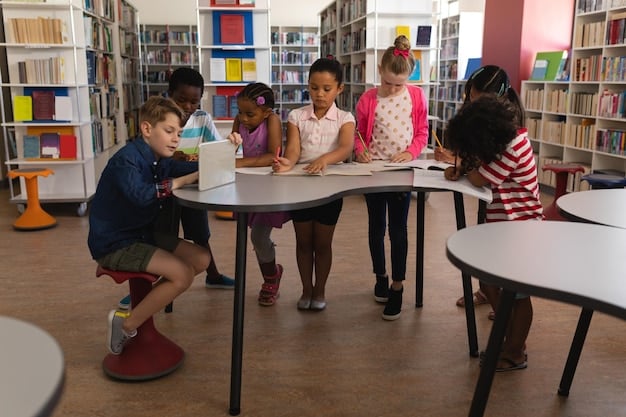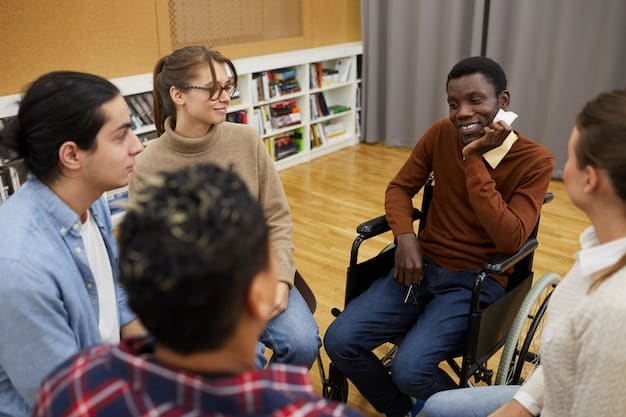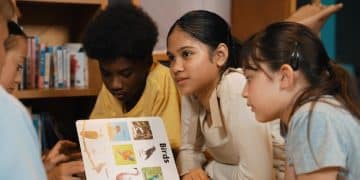How to Create a Positive and Inclusive Classroom Environment

Anúncios
Creating a positive and inclusive classroom environment involves implementing strategies that foster respect, empathy, and understanding among students, ensuring all learners feel valued, safe, and supported to achieve their full potential.
In today’s diverse classrooms, cultivating a welcoming space where every student feels valued is more crucial than ever. But how can educators effectively create a positive and inclusive classroom environment? Let’s explore strategies that foster respect, empathy, and academic growth for all students.
Anúncios
Understanding the Importance of a Positive Classroom Environment
A positive classroom environment extends far beyond simple good behavior. It’s about creating a space where students feel safe, respected, and motivated to learn. Such an environment fosters not only academic success but also social and emotional development.
Academic Benefits of Inclusion
When students feel secure and accepted, they are more likely to participate in class, ask questions, and take academic risks. This engagement directly impacts their learning outcomes.
Anúncios
Social and Emotional Benefits
A positive and inclusive classroom cultivates empathy, respect, and understanding among students. It helps them develop social skills and emotional intelligence, preparing them for success in diverse settings.
- Reduced Bullying: Inclusive classrooms have fewer instances of bullying and harassment.
- Improved Mental Health: Students in positive environments report lower levels of anxiety and depression.
- Enhanced Collaboration: Inclusive settings promote teamwork and collaboration among students with diverse backgrounds and abilities.
In conclusion, understanding the importance of a positive classroom environment goes far beyond simple management of behavior. It involves creating a holistic space where students feel safe, respected, and motivated, enhancing their academic, social, and emotional growth comprehensively.

Strategies for Fostering Inclusion
Creating an inclusive classroom requires proactive strategies that address the diverse needs of all students. These strategies should focus on promoting understanding, respect, and equity.
Promote Culturally Responsive Teaching
Culturally responsive teaching involves recognizing and valuing the cultural backgrounds of all students. It requires adapting your instruction to meet the unique needs and learning styles of diverse learners.
Implement Universal Design for Learning (UDL)
UDL is a framework that guides the development of flexible learning environments that can accommodate individual learning differences. It ensures that all students have equal opportunities to succeed.
- Multiple Means of Representation: Offer content in various formats (e.g., visual, auditory, kinesthetic).
- Multiple Means of Action and Expression: Allow students to demonstrate their learning in different ways (e.g., essays, presentations, projects).
- Multiple Means of Engagement: Provide options that motivate and engage students with different interests and learning preferences.
Effective inclusion requires fostering empathy and understanding among students. This can be achieved through activities that promote perspective-taking and cultural awareness.
Building a Respectful Classroom Culture
A respectful classroom culture is the foundation of an inclusive learning environment. It requires setting clear expectations and consistently modeling respectful behavior.
Establish Clear Expectations
Clearly define and communicate classroom rules and expectations. Involve students in the creation of these rules to foster a sense of ownership and responsibility.
Model Respectful Behavior
As the teacher, you must model the behavior you expect from your students. Treat everyone with respect, listen actively, and value diverse perspectives.
Implement restorative justice practices to address conflicts in a constructive and empathetic way. This approach focuses on repairing harm and rebuilding relationships, rather than simply punishing offenders.
Building a respectful classroom culture involves more than just setting rules; it’s about fostering a community where every student feels valued and heard, creating a safe and inclusive learning environment.

Addressing and Preventing Bullying
Bullying can undermine the positive climate of a classroom and have devastating effects on students. It’s essential to have strategies in place to address and prevent bullying effectively.
Implement Anti-Bullying Policies
Develop and enforce clear anti-bullying policies that outline consequences for bullying behavior. Make sure students understand these policies and the reporting procedures.
Teach Empathy and Conflict Resolution Skills
Equip students with the skills to understand and respond to bullying situations. Teach them how to empathize with others and resolve conflicts peacefully.
- Role-Playing: Use role-playing scenarios to practice assertive communication and bystander intervention.
- Group Discussions: Facilitate discussions about bullying and its impact on individuals and the community.
- Educational Resources: Provide access to books, videos, and websites that address bullying and promote kindness.
Regular check-ins and open communication are critical to ensuring students feel safe and supported. Create opportunities for students to share their concerns, either privately or in group settings.
Engaging Parents and Community
Creating a positive and inclusive classroom is not solely the responsibility of the teacher. Engaging parents and the wider community can significantly enhance your efforts.
Communicate Regularly with Parents
Keep parents informed about classroom activities, policies, and any concerns related to their child’s well-being. Use various communication methods, such as newsletters, emails, and parent-teacher conferences.
Involve Parents in Classroom Activities
Invite parents to participate in classroom events, volunteer, or share their expertise with students. This helps build a stronger connection between home and school.
Partner with local organizations and community leaders to bring diverse perspectives and resources into the classroom. This collaboration enriches the learning experience and provides students with real-world connections.
Assessing and Adapting Your Approach
Creating a positive and inclusive classroom environment is an ongoing process. Regularly assess your strategies and adapt them to meet the evolving needs of your students.
Gather Student Feedback
Solicit feedback from students about their experiences in the classroom. Use surveys, interviews, or informal discussions to gain insights into what is working well and what needs improvement.
Reflect on Your Practices
Take time to reflect on your teaching practices and their impact on inclusion. Consider what adjustments you can make to better support all students.
Stay informed about best practices in inclusion by attending workshops, reading professional literature, and collaborating with colleagues. Continuous learning will help you refine your approach and create a more inclusive classroom.
| Key Aspect | Brief Description |
|---|---|
| 🤝 Respectful Culture | Establishing clear expectations and modeling respectful behavior. |
| 🛡️ Bullying Prevention | Implementing anti-bullying policies and teaching empathy skills. |
| 👨👩👧👦 Parent Engagement | Communicating regularly and involving parents in activities. |
| 📚 UDL Implementation | Using flexible learning environments accommodating individual differences. |
Frequently Asked Questions (FAQs)
▼
An inclusive classroom is a learning environment where all students, regardless of their backgrounds, abilities, or challenges, are fully welcomed, valued, and supported. It emphasizes equity and participation for every learner.
▼
Effective bullying intervention involves implementing clear anti-bullying policies, teaching empathy and conflict resolution skills, and regularly checking in with students to create a safe and supportive environment.
▼
Parent engagement strengthens the connection between home and school, providing students with a consistent support system. It also brings diverse perspectives and resources into the classroom, enriching the learning experience.
▼
UDL is a framework that supports flexible learning environments accommodating individual differences. It provides multiple means of representation, action, and engagement, ensuring all students have equal access to learning.
▼
Culturally responsive teaching involves recognizing and valuing students’ cultural backgrounds. Adapt your instruction to meet diverse learning styles, use relevant materials, and celebrate cultural diversity in your classroom.
Conclusion
In conclusion, creating a positive and inclusive classroom environment is essential for fostering academic, social, and emotional growth in students. By implementing strategies that promote respect, understanding, and equity, educators can create a welcoming space where every student feels valued and empowered to succeed.





